Haute coutourier Rikki of the ever-creative & forever-opposed TWIG-Atta Girls unveiled her new spring/summer line in Plymouth NH tonight. What will be the fashion trend for 2011?
The reclusive Rikki herself made a rare appearance to narrate the debut of her new spring/summer collection. She previewed the show by noting that orange is the new black; it is very slimming and looks superb on everyone. First out on the catwalk was Lumber Jan, who modeled Rikki's opening piece for the night, pre-greased orange Labonville chaps complemented by a matching color safety helmet with ear protectors and contrasting mesh visor. Rikki's understated elegance restrained her from accoutering Lumber Jan with an orange Stihl or Husky chainsaw. In fashion, as in life, so often less is more. Next on the catwalk was Recycling Shelly, making a utilitarian and environmentally-friendly statement in her reversible orange and neon lime green sandwich-board poster, "No Northern Trespass!" So bold, so expressive, so true. The piece de resistance, that final work that sums up the designer's intent for the collection, was Hazmat Heather, whose orange jumpsuit revealed fine detail and craftsmanship and a unity of purpose that only a one-piece garment can provide.
The goal of every fashion show is to showcase the designer's overall vision. What is Rikki envisioning for 2011? ORANGE, ORANGE, ORANGE!!!!
After the unveiling, Rikki invited orange fashionistas in the audience to come up and mingle with the models, prizes were distributed to budding designers, and press photos snapped.
Thursday, March 31, 2011
Wednesday, March 30, 2011
HB 648 Legislator Winners
HB 648, a bill to tighten NH eminent domain laws, passed the House 317-51 today. Below are pictures of the four Representatives who rose to speak in favor of the bill. We'll show you the losers some other time. For now, a big round of applause for Reps. Pastor, Garrity (Chair), and especially for Reps. Larry Rappaport and Rick Ladd, bill co-sponsors.
 |
| Rep. Pastor |
 |
| Rep. Rick Ladd |
 |
| Chairman Garrity |
 |
| Rep. Larry Rappaport |
 |
| HB 648 vote: 317 for, 51 against |
 |
| Some Happy Campers on the Capitol Steps after the Vote |
Monday, March 28, 2011
TWIG's Scoping Report from Mount Lafayette
Scoping comment: "We respectfully request that the DOE summit Mount Lafayette and hike the Franconia loop in order to understand what the towers will look like from the most popular trail in the White Mountains."
| TWIG on top, Mount Lafayette (1) TWIG on top, Mount Lafayette (2) |
TWIG's Trip Report
Hello Comrades,
Today, four of us from 'TWIG' and our malamute snowshoed one of the most
popular trails in the White Mountains, the Bridle Path trail on Mt. Lafayette.
The weather was pretty darn cold and windy, the camera froze after a few shots.
We can testify that if the monster scheme went through, the towers would be seen
from this majestic trail immediately above treeline. The entire Franconia Ridge trail
including Lafayette, Lincoln, Little Haystack, Liberty & Flume would be subject to
the despicable 'things'.
Also affected would be Cannon Mt., the Cannon Balls, Fishin' Jimmy Trail,
North & South Kinsman peaks and another very popular climb, Mt. Moosilauke.
Attached is a photo from today.
We are determined to be NHIMBY's: New Hampshire Is My Backyard!!!!
Onward!
Friday, March 25, 2011
How Tall Could the Towers Be?
Northern Pass has now embarked on a publicity campaign that "visualizes" towers in landscape settings. Various statements about tower heights accompany these "simulations." There are discrepancies between the document of record, the Presidential Permit application (PPA) filed in October 2010, and recent publicity statements. Let's review the document of record first and then look at the publicity material to see how high the DC towers could be. (AC towers from Franklin south are not discussed here.) This is Part 1 in a series. Coming next in Part 2: How wide could the ROWs be?
What Northern Pass said in the Presidential Permit application about DC tower heights
For the portion of the Project running from the international border to Franklin, New Hampshire, Northern Pass proposes to construct a single circuit ±300 kV HVDC above-ground transmission line that will be mounted on structures ranging from approximately 90 feet to 135 feet tall. (p. 9)
For both the monopole and lattice configuration, the horizontally configured structures would be approximately 90 feet in height, and the vertically configured structures would be approximately 135 feet in height. [Ftnt. 4] (pp. 11-12)
Structure heights are typical for a straight, level stretch of land. Actual structure heights will vary, and may be greater in height (e.g., highway crossings), based on topography, span length and the line layout. (footnote 4, p. 12, emphasis added)
Which do you believe: the document of record (PPA) that, in the small print of footnote 4, places no limit whatsoever on DC tower height, or the promotional "Project Journal," which limits tower height to 135'?
Keep this in mind as you see tower simulations that Northern Pass will place in newspapers and elsewhere over the next week or so. Also keep in mind that simulations may show you towers out of context, not in a clearcut ROW anywhere from 150' to 400' wide, or show you towers from advantageous perspectives. Note the small print--"for illustrative purposes only, based on preliminary engineering." Keep all this in mind and you will understand why the DOE has been asked to require a professional, independent, third-party visual simulation that is not for Northern Pass's "illustrative purposes" but for the purposes of accurately informing landowners and others what the visual impact of Northern Pass towers will be.
What Northern Pass said in the Presidential Permit application about DC tower heights
For the portion of the Project running from the international border to Franklin, New Hampshire, Northern Pass proposes to construct a single circuit ±300 kV HVDC above-ground transmission line that will be mounted on structures ranging from approximately 90 feet to 135 feet tall. (p. 9)
For both the monopole and lattice configuration, the horizontally configured structures would be approximately 90 feet in height, and the vertically configured structures would be approximately 135 feet in height. [Ftnt. 4] (pp. 11-12)
Structure heights are typical for a straight, level stretch of land. Actual structure heights will vary, and may be greater in height (e.g., highway crossings), based on topography, span length and the line layout. (footnote 4, p. 12, emphasis added)
To summarize, in the document of record, Northern Pass states that horizontally configured DC towers (energized conductors side-by-side) will be "approximately 90 feet"; that vertically configured DC towers (see illustration below) will be "approximately 135 feet"; but both "may be greater in height" than approximately 90' and approximately 135'. OK . . . .what is "approximately 90 feet"? 80 feet? 100 feet? What is "approximately 135 feet"? 150 feet? And what is "greater in height" than approximately 135 feet, which might actually be 145 feet or 150 feet? 180 feet?
How tall could the DC towers be? According to the PPA, the sky's the limit.
How tall could the DC towers be? According to the PPA, the sky's the limit.
What Northern Pass is Saying Now in Promotional Statements
In its Project Journal posted on March 25, 2011, however, Northern Pass tells a different story about maximum tower height:
Taller structures (up to 135 feet) will only be used along the route when necessary:
- To span larger rivers and roadways;
- To account for changes in terrain being spanned by the line, and maintain a consistent distance between the transmission wires and the ground; and
- In select areas in the existing ROW where the ROW is constrained and cannot be expanded to a width necessary for shorter structures.
Keep this in mind as you see tower simulations that Northern Pass will place in newspapers and elsewhere over the next week or so. Also keep in mind that simulations may show you towers out of context, not in a clearcut ROW anywhere from 150' to 400' wide, or show you towers from advantageous perspectives. Note the small print--"for illustrative purposes only, based on preliminary engineering." Keep all this in mind and you will understand why the DOE has been asked to require a professional, independent, third-party visual simulation that is not for Northern Pass's "illustrative purposes" but for the purposes of accurately informing landowners and others what the visual impact of Northern Pass towers will be.
Oh, by the way, Exhibit B, sheet 2 of the PPA depicts a 140' tower (64' + 76'). Maybe that's what "approximately 135 feet" means in the PPA. But no matter, the sketch is just "preliminary--not for construction." The sky's the limit.
| HVDC line (center) flanked by two HVAC lines on the National Grid ROW, Haverhill area |
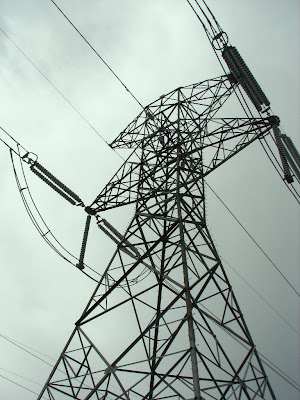 |
| National Grid HVDC tower on Rte. 302 near Bath and Swiftwater NH |
Coming next: How wide could the ROWs be? (Preview: as wide as necessary.) And, what tower heights are in store for the narrow ROW in the WMNF? (Preview: the sky's the limit.)
Thursday, March 24, 2011
On behalf of New Hampshire's moose
Highlights from the Department of Energy
scoping meetings, March 14-20, 2011
scoping meetings, March 14-20, 2011
From the Haverhill Meeting (March 20)
| Michelle Vaughan testifying, March 20 |
Michelle Vaughan testified on behalf of New Hampshire's moose, which are unanimously opposed to Northern Pass. Eminent domain is not an option to take their land. You can hear an audio version of the rest of Michelle's testimony on radio host Brian Tilton's site.
This 1200 pound bull moose in Alaska could have used Michelle's help. It got caught up in power lines being tightened by a hydraulic winch miles away and was hoisted 50' aloft.
Snopes.com verifies the story and narrates its conclusion.
This 1200 pound bull moose in Alaska could have used Michelle's help. It got caught up in power lines being tightened by a hydraulic winch miles away and was hoisted 50' aloft.
Snopes.com verifies the story and narrates its conclusion.
Sunday, March 13, 2011
Some thoughts on political process on the eve of DOE hearings
This weekend, we, the opposition, are poised between two political processes, legislative hearings in Concord last week, and Department of Energy (DOE) public scoping meetings all over New Hampshire starting tomorrow. Many are still uncertain, troubled, about what actually happened in Concord last week. We know we saw lobbying up close and personal, many of us for the first time, and we are unclear what "retaining" a bill will ultimately mean about its chance of passage. Is it a circuitous way of killing it or a genuine effort to study and strengthen it? We may well end next week with the same questions, concerns, and uncertainties about what happened and will happen. We still don't know who the replacement EIS contractor is the day before the hearings begin, and we have no say in its selection. We may find that the DOE is not the "regulator" that we might expect, a body that polices and protects, but an agency whose mission is divided between studying and siting this transmission project.
It is frustrating to be largely novices in these two intricate political processes when the stakes are so high for us, and it is equally annoying to be deprived of basic information. We may wish that we all had the inside track and could play the system like pros. But I am reminded of what Senator Paul Wellstone said about an opposition group of Minnesota farmers who fought a massive HVDC transmission project with 180' towers that was sited to run through their prime rural farmlands in the mid 1970s. It was the first major battle in America over such a transmission project. Wellstone was helping this group navigate hearings in the state capitol two years into the process, and he was surprised that the opposition still did not even know where the key legislators' offices were. How could they have gotten as far as they had in slowing down the project? But then it occurred to Wellstone that the opposition had gotten as far as it had precisely because it still did not know where the key legislators' offices were.
Wellstone's point is that grass roots opposition groups will never be as versed as politicians and regulators are in conventional political process, and we might think carefully about expending all our energy trying to compete like professionals in arenas foreign to us. Opposition groups must define their own political processes and actions. We don't control the timetable; instead, we must seize the opportunities that arise and use them creatively. We have done so brilliantly. None of us wanted this project thrust upon us just before the holidays; none of us has enjoyed driving all over the state in one of the hardest winters in recent memory to meet Northern Pass's urgent timetable. But that same timetable gave us huge snow banks, and we planted dozens of hand-painted orange protest signs in them that have captured media attention; it gave us town meetings in March, and we seized the opportunity to make a loud and clear statement about opposition to Northern Pass. 29 towns are now on record opposing the project. With all its lobbyists and money and state-of-the-art strategy, Northern Pass will never be able to buy publicity like that. Who has written a song in favor of Northern Pass? Who has painted a sign promoting the towers?
Wellstone goes on to document how, when the Minnesota power line was built and in test phase, the farmers' protest escalated into guerrilla warfare and sabotage. The farmers found a way to unbolt tower legs, apply leverage in just the right places, and topple the massive lattice work structures. Under cover of dark, seven went down. It was surprisingly easy. In addition to these "bolt weevil" attacks, "insulator disease" also struck at night, with the ground covered with shattered glass in the mornings. The assaults on the towers stopped not because of the armed response and legal action, which did ensue, but because the opposition communities disapproved of such risky and dangerous activity and exerted social control over their own members.
The story of the Minnesota power line, built to transmit coal-generated electricity to the Twin Cities across rural America, is a case study of everything that was wrong with American energy policy--and still is. One can map much of what happened there directly onto what is happening again in NH today. And the story did not have a happy ending. But Wellstone's point that the opposition got as far as it did because it did not know its way around the traditional halls of power and influence, not in spite of it, is worth contemplating.
Grass roots opposition to the outdated and destructive technology of massively long and high overhead transmission lines has matured since the Minnesota effort of the mid '70s. The defeat of the New York Regional Interconnect overhead project, and the subsequent birth of the underground Champlain Hudson Power Express project now in permitting stage, is a good example. In New York, the people were able to connect to conventional political process and use it to best advantage. The result is a stunning success story.
But in New York, just as in Minnesota forty years ago and in New Hampshire today, the opposition also remained highly committed to nontraditional political activities, to spontaneous, improvised, creative, energetic, even humorous and satiric protest that emerges in response to events as they unfold. We have those few who can put on power suits and haunt the corridors of political influence, and we have those many who can put on blaze orange and seize the day out in the field--in the town hall meetings, the Snodeos, and all the other places that Northern Pass does not dare to go.
We need both, our tent is large, and we must all walk together in balance and mutual support.
(Much of Paul Wellstone's and Barry M. Casper's Powerline: The First Battle of America's Energy War [1981, 2003] can be read online. A good, short analytical review of the book and what went wrong in Minnesota and in American energy policy is here. And, you can read part of Noel Perrin's essay, "The Lesson of the Bolt Weevils," from Best Person Rural, here. Perrin comments on the good that came out of opposition to the CU power line in Minnesota.)
Tuesday, March 8, 2011
Town Meeting Tally
Please report your town's vote to burynorthernpass<at>gmail.com
29 Towns Have Voted to Oppose Northern Pass
29 Towns Have Voted to Oppose Northern Pass
Bath, Bethlehem, Bridgewater, Campton, Chichester, Clarksville, Colebrook, Columbia, Dalton, Easton, Effingham, Haverhill, Holderness, Jefferson, Lancaster, Landaff, Lincoln, Littleton, New Hampton (4/16), Northumberland, Orford, Pembroke, Pittsburg, Stewartstown, Stratford, Sugar Hill, Thornton, Wentworth, Woodstock
Additional Towns Whose Selectmen Registered Town Opposition in Presidential Permit Interventions (December 2010):
Plymouth
Grand Total of Towns In Official Opposition to Northern Pass To Date:
30
Additional Towns Whose Selectmen Registered Town Opposition in Presidential Permit Interventions (December 2010):
Plymouth
Grand Total of Towns In Official Opposition to Northern Pass To Date:
30
| (Mike Marland editorial cartoon from the Monandnock Shopper News, March 2-8, 2011) |
Sunday, March 6, 2011
Sign Gallery (31-40): Snodeo Weekend
The Opposition table and signs in and around Snodeo March 5-6, 2011.
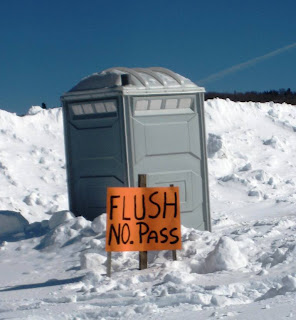 |
| 31. Protest area outside Coleman State Park |
 |
| 32. Opposition trio in protest area on Diamond Pond Road into Snodeo |
 |
| 33.Sign series lining road into Snodeo |
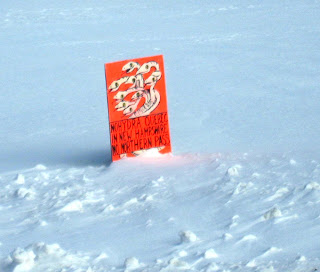 |
| 34. Linda Samson sign in protest area (her original of this sign is located on Rte 116, Easton) |
 |
| 35. Sign by Russ and Kathy Johnson (Columbia) temporarily located on Diamond Pond Road for Snodeo |
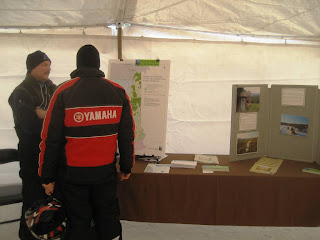 |
| 36. Jack Savage (left), SPNHF, at Opposition table, Snodeo |
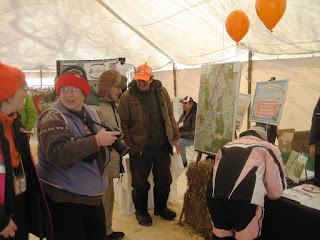 |
| 37. Julie Moran, left, Mark M? (orange hat) at Opposition table, Snodeo |
 |
| 38. Rick Johnson, center front, at Opposition table, Snodeo |
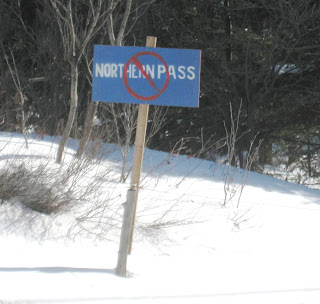 |
| 39. Roland Cotnoire, Rte. 26, Colebrook |
 |
| 40. Mulie Moran, Rte. 26, Colebrook |
Town Hall Talk
Over the next few days as town meetings approach, this resource post will be updated. Please bookmark and check back. Each town is different, but if you have facts and figures about your town to share, please submit them to burynorthernpass<at>gmail.com.
- Property taxes. In Atlanta in March 2010, to an audience of energy industrialists, PSNH was forthright about the difficulties of "selling" Northern Pass back in New Hampshire. PSNH economic and community development director Patrick McDermott stated outright that property tax benefits to towns other than Franklin would not amount to much. McDermott considered this a "negative": “The negatives are that this project will not generate a lot of property taxes. Most of that will come from the converter station, which is a $200-million-plus investment.” (Read the other "negatives" here.)
- Electric bills. Using Northern Pass's own New England electric wholesale price projections for 2015 and NP's aggressive assumptions of 100% pass-through of wholesale price reductions to retail customers, the upper end of the savings range for New Hampshire families is only 97 cents a month or only 1% of the average 2009 $96.66 monthly electric bill. It is highly unlikely that NP would pass on 100% of wholesale price reductions; the actual savings are likely to be 0 to 97 cents per month. (15-page calculation and supporting documents available upon request.)
- Real estate values. According to the preliminary results of one professional "before and after" appraisal of a representative 12-acre parcel of high-quality view land in Dalton NH that would be bisected by a new right-of-way for the Northern Pass transmission lines, the project would have a very large impact on market value, reducing market value by 50%-83+%. Another realtor with 35 years of experience in northern New Hampshire believes the market value is likely to be reduced 100%, i.e., the parcel would be unmarketable. Sales have already fallen through because of the mere threat of the HVDC line. Sellers must disclose their proximity to the preferred and alternate routes.
- Taxes "in lieu." The taxes on the proposed new power lines will be “Taxes in Lieu,” which exempts N-star and H-Q from paying the largest portion of NH’s property taxes that supports education. The remaining smaller portion they will pay to the cities and towns of NH will be reduced over time as a result of the depreciated value of the towers and transmission lines.
- One town's "profit." On the approximately 7-8 miles of PSNH HVAC lines running through Sugar Hill on the existing right-of-way, the town collected $16,000 in 2010. A new HVDC line might generate more revenue provided the town were willing to pay for the appraisal, but depreciation would quickly reduce this benefit. Easton's figure is apparently much lower, $2,000.
- Property tax abatements. Municipal requests for property tax abatements from owners affected by the mere threat of Northern Pass transmission lines were due on March 1. No figures are available yet on the number and amount of abatements requested. If abatements are granted, the effect will be to raise property taxes for other owners in town.
- Federal Housing Administration mortgages. FHA rules prohibit the issuance of insured loans for homes located adjacent to high voltage transmission power lines. (See Section J.)
- Cost of alternatives to Northern Pass's above-ground transmission lines, such as burying the lines. Modest changes to the financing structure of the Northern Pass project can maintain a high level of profitability for the sponsors and at the same time potentially free up substantial capital (in the range of $600-$900 million) for investment in less impactful alternatives such as burying the lines. Alternatives are not "too expensive." (20-page calculation and supporting documents available upon request.)
- Fact check for the economic analysis in the most recent Northern Pass mailer. Read the small print. Look on the back of the page, "Sources and Notes," and you will see the disclaimer: "Any potential reductions or increases in other property values as a result of the addition of NPT are not covered in this report." You should also be aware that the "analysis" has been prepared by Dr. Lisa Shapiro, who is the "Chief Economist" for Gallagher, Callahan and Gartrell, the Concord Law Firm representing the Northern Pass in its proceedings with the State of New Hampshire. This is not an independent analysis. At the HB302 hearing several weeks ago, Rep, Garrity asked Dr. Shapiro if her analysis took offsets and reductions into account, and she replied that it did not.
Tuesday, March 1, 2011
Northern Pass and the WMNF (Part 1)
In order for Northern Pass to go through ten miles of the White Mountain National Forest in the towns of Easton, Woodstock and Lincoln, it will need to obtain a Special Use Permit from the Forest Service. It cannot take federal land by eminent domain. This post and the next one will examine recent policy decisions regarding the WMNF and the Special Use Permit process. Today is the 100th anniversary of the Weeks Act, legislation named after sponsor John Wingate Weeks of Lancaster NH that created the WMNF and other eastern national forests.
Recent Policy Decisions: The 2005 Forest Plan
In 2005, the WMNF completed an exhaustive eight-year study to chart its course for the next ten to fifteen years. Unlike National Parks, National Forests are designed for multiple use, including timber harvest, and finding the right balance of activities for the WMNF with its 7 million annual visitors was a challenging task. 6,000 public comments were collected, numerous public hearings occurred, and a veritable library of study documents was generated. Special attention was given to the impact of the WMNF on towns like Easton, Woodstock and Lincoln, which lie within the overall forest boundary.
The 2005 plan represents a compromise, of course, but there is an underlying direction in its provisions to manage the 800,000 acre WMNF as a natural and scenic refuge. Alternative 2, which was selected at the end of the process, reduced the allowable timber harvest by one quarter; it added 34,500 acres to the existing wilderness areas, increasing total wilderness acres in the forest to approximately 130,000; and it continued its ban on all-terrain vehicles.
Implementing the 2005 forest plan, The New England Wilderness Protection Act of 2006 increased the Sandwich Range Wilderness to its present size and created the Wild River Wilderness area. These areas now follow regulations designed to lessen the evidence of human impact on nature. Trails will not be brushed and otherwise maintained to the same standard as in non-wilderness areas; unpainted natural color wooden trails signs, fewer and further apart, will replace more obtrusive ones; painted trail blazes on trees will not be refreshed; when existing shelters require maintenance, they will be removed; dispersed and compacted earth tent pads will replace wooden decks; bridges will be removed; and so forth. For those of us who treasure the old Wild River shelters, even the dilapidated one in muddy Perkins Notch, it's like losing old friends to see them go. But it's an acceptable trade-off that acknowledges the WMNF's mission to offer its users the chance to experience solitude in nature, a vanishing resource for the millions of visitors who live within a day's drive of the forest in the densely populated urban centers of the Northeast.
A compatible and highly perishable resource in the urban Northeast are natural scenic vistas, and throughout the 2005 planning documents, natural landscapes are consistently elevated as one of the WMNF's most important assets. The Executive Summary of the decision to choose Alternative 2 notes that all four possible alternatives prioritized natural scenery:
Research indicates that beyond their contribution to tourism, high quality
Recent Policy Decisions: The 2005 Forest Plan
In 2005, the WMNF completed an exhaustive eight-year study to chart its course for the next ten to fifteen years. Unlike National Parks, National Forests are designed for multiple use, including timber harvest, and finding the right balance of activities for the WMNF with its 7 million annual visitors was a challenging task. 6,000 public comments were collected, numerous public hearings occurred, and a veritable library of study documents was generated. Special attention was given to the impact of the WMNF on towns like Easton, Woodstock and Lincoln, which lie within the overall forest boundary.
The 2005 plan represents a compromise, of course, but there is an underlying direction in its provisions to manage the 800,000 acre WMNF as a natural and scenic refuge. Alternative 2, which was selected at the end of the process, reduced the allowable timber harvest by one quarter; it added 34,500 acres to the existing wilderness areas, increasing total wilderness acres in the forest to approximately 130,000; and it continued its ban on all-terrain vehicles.
Implementing the 2005 forest plan, The New England Wilderness Protection Act of 2006 increased the Sandwich Range Wilderness to its present size and created the Wild River Wilderness area. These areas now follow regulations designed to lessen the evidence of human impact on nature. Trails will not be brushed and otherwise maintained to the same standard as in non-wilderness areas; unpainted natural color wooden trails signs, fewer and further apart, will replace more obtrusive ones; painted trail blazes on trees will not be refreshed; when existing shelters require maintenance, they will be removed; dispersed and compacted earth tent pads will replace wooden decks; bridges will be removed; and so forth. For those of us who treasure the old Wild River shelters, even the dilapidated one in muddy Perkins Notch, it's like losing old friends to see them go. But it's an acceptable trade-off that acknowledges the WMNF's mission to offer its users the chance to experience solitude in nature, a vanishing resource for the millions of visitors who live within a day's drive of the forest in the densely populated urban centers of the Northeast.
A compatible and highly perishable resource in the urban Northeast are natural scenic vistas, and throughout the 2005 planning documents, natural landscapes are consistently elevated as one of the WMNF's most important assets. The Executive Summary of the decision to choose Alternative 2 notes that all four possible alternatives prioritized natural scenery:
Research indicates that beyond their contribution to tourism, high quality
scenery and a natural appearing landscape enhance people’s physical and
psychological well being. Given the large population within a day’s drive of
the White Mountains and increasing populations near the Forest, the scenic
attributes of the White Mountain National Forest benefit a large portion of
the people in the northeast. All four alternatives would retain the vast
majority of the Forest in natural appearing conditions, so all should continue
providing these non-priced benefits. (Record of Decision Executive Summary)
As you drive north on I-93 and round the bend near Exit 28, the majestic vista of the Franconia mountains suddenly unfolds before your eyes. It's for good reason that 19th century travel writers dubbed this area "the gateway." For those of us who live in the North Country, when the confines of the near ground drop away and this view opens up, we know that we are home again; and those who visit from down under realize that they are finally away from home. Everyone who has seen this view instantly understands what the Forest Service meant when it wrote that high quality scenery and a natural appearing landscape enhance our physical and psychological well being. This is not merely a "non priced benefit" of the WMNF, it's a priceless benefit, one vigorously defended and prized in the 2005 forest plan. It is now under attack by the proposed Northern Pass project, which would place a row of 90-135' steel towers right across the gateway and up into the breath-taking vista if it is granted a special use permit.
Sign Gallery (21-30)
 Please send pictures of signs opposing Northern Pass to burynorthernpass<at>gmail.com and we'll post them here. Each sign gallery will feature ten signs. Sign Gallery 1-10 is here, Gallery 11-20 is here.
Please send pictures of signs opposing Northern Pass to burynorthernpass<at>gmail.com and we'll post them here. Each sign gallery will feature ten signs. Sign Gallery 1-10 is here, Gallery 11-20 is here. |
| #21. Rte. 3, Stratford. March 1, 2011. |
Subscribe to:
Posts (Atom)






